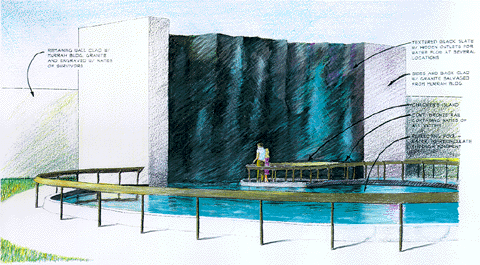"In the face of heartbreaking loss and chilling evil, the people of Oklahoma City showed the world the great strength that tragedy can reveal. This memorial is dedicated to that strength, and to the memory of those who died -- a place for reflection and remembrance, healing and hope." Those were the opening words of the descriptive narrative I wrote about my entry into the Oklahoma City Memorial Design Competition. This competition was established to select a fitting memorial of the bombing of the Alfred P. Murrah federal building on April 19, 1995. On Saturday, the finalists for that competition were announced. I was not be one of them. That's OK, there were over 600 entries, from all over the world, and while I gave my entry the best effort I could, the entry itself was not what was important. Participating in the healing was what mattered. That bomb didn't just kill and maim those who were in the area. It ripped open a hole in all our hearts, and touched the entire nation. Afterwards, all of us needed a little healing, and something to hope for. I think that is why the spirit of Oklahoma City that we saw in the days following the bombing was so touching, and why so many of us from around the country and the world felt compelled to help however we could. Some people went to help with the search and rescue effort. Some gave blood. Some said prayers. Some sent origami cranes -- cranes by the thousands -- to show their support and give strength to the injured. In each case the effort to help, to heal, helped us to cope with the tragedy. For me, that meant entry into the design competition, to offer one idea for a memorial that I hoped would give comfort. To prepare for the competition, my wife and I travelled to Oklahoma City, met with some of the survivors, talked with people who lost friends and family members. We viewed the site, read the reports, tried as best we could to imagine the scene that day in April two years ago. And through it all one thing was clear: the people of Oklahoma City were doing everything they could to heal, to move on. Not forgetting the losses they suffered, but also not willing to allow those losses to define them or control their lives. Their scars were fresh, still pink and I'm sure still painful, but that pain was not what you saw, not what you heard when you talked with them. Rather, there was hope, and determination, and a kind of grace. I don't know what the final form of the memorial will be. And I don't know what may be written upon it, or what images may be used by the designers. But I do know that in the heart of Oklahoma City there will always be hallowed ground, and a symbol of the strength of the human spirit that none of us should ever forget. If I were a rich man, I would give some of my wealth to help build that monument. As it is, I will give what I can, because the people of Oklahoma City taught me much, and gave me a kind of hope that all of us need from time to time. |
A place of healing and remembrance
narrative description of our entry
In the face of heartbreaking loss and chilling evil, the people of Oklahoma City showed the world the great strength that tragedy can reveal. This memorial is dedicated to that strength, and to the memory of those who died -- a place for reflection and remembrance, healing and hope.
The monument is of the same proportion and shape as the Murrah building immediately following the bombing. It is clad in granite recovered from the original building, with simple, rough-cut black slate across the face of the monument. From several sources on the face, water springs forth: tears weeping down, washing away grief in a quiet, never ending trickle. These tears join in a pool before the monument, just as the nation and the world joined with the people of Oklahoma City in the days and weeks following the bombing, as we learned the stories of the lost, the injured, and those who helped in the aftermath. A railing runs from one end of the monument to the other, encompassing the pool, and bears the victims' names.
A simple bridge crosses the pool to an island in the center. That island -- the focus of the memorial -- lies just in front of the face of the monument. The names of the children who perished are gathered together on the rail of the island. Behind the monument, etched into the granite facing of the wall bordering the GSA plaza, are the names of the survivors by location.

Click on the image to get a larger version (564k interlaced GIF)
© James Downey & Martha John
Thanks to P. Michael Hook for assistance with the rendering, to Charles Strain for the use of his sculptural images in formal entry, and Joseph Heck & Karen Williams for design of this website.